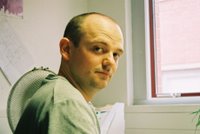1. I have one
2. It makes a variety of sounds
3. It will look great in a photo
I wil keep a detailed account of how these samples are produced in order to make comparrisons between recordings later.
Machine:

Model: Hotpoint WD73
Max Spin speed: 1200RPM
Wash:
Programme C: 40 degree wash
Contents of drum: 4 sheets, 2 towels
Duration: Approx 75 mins
Mics & Locations:
1 x Stagg MC07 Condenser - Near water dispenser
1 x Samson Q Kick - In front of
 drum
drumThe Recording:
Each mic is recorded to a separate channel so that the sounds can be adjusted independently, which falls in line with the multiple mic positions used in Propellerheads Reason Piano. The user will be able to vary the sounds heard by altering the different levels using a mixer.
I did want to use more mics, but I'm currently limited to 2-Track simultaneous recording (a limitation I will soon be resolving). I did get a good mix and it's interesting to hear the differences between the mic locations. The 'drum' mic obviously recorded more of the low rumbling sounds as the machine turned, whirred and spun, whereas the 'water dispenser' mic excellently captured the sounds of the machine filling up.
Conclusion:
This was a great first experiment and I'm looking forward to processsing the results. I think the washing machine can make a great virtual instrument. There was an excellent variety of sounds which will make for some great sampled patches. I think I should record a washing machine again and maybe include the following:
- Sounds of the door opening & closing
- Sounds of the selection buttons
- Additional mic placed outside to record water drainage
- Additional mic recording the sound of the 'space' (kitchen)
- Additional mic placed in the drum*
* Ok so this one's risky, particularly for the mic spinning at 1200 RPM. It can only be done using a wireless model in order to prevent cable entanglement which means that it's a bit of an expensive risk. Obviously it would be shielded from the water.....hmmm I'll have a think.
